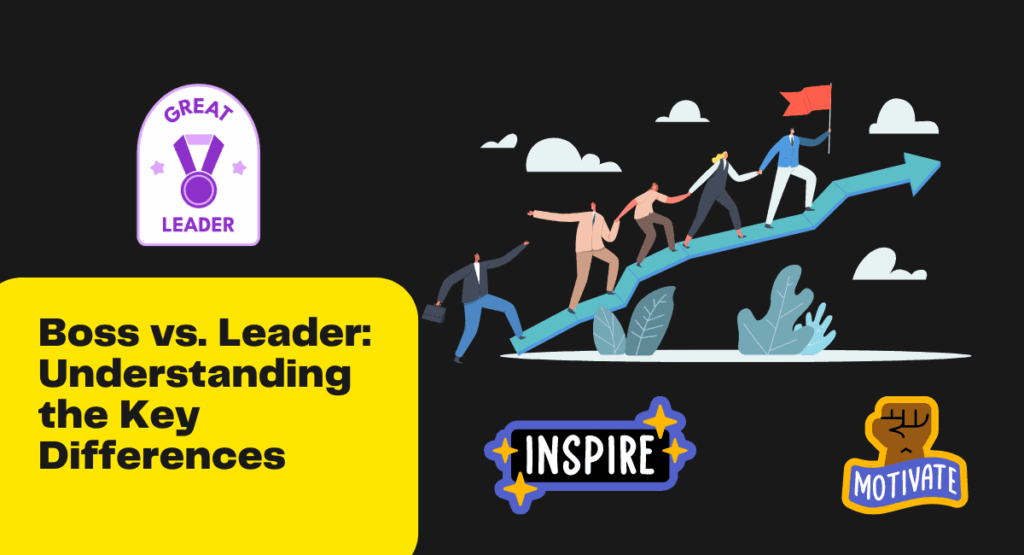Boss vs Leader: Understanding the Key Differences


Many people quickly think of a boss as someone who gets things done.
However, the roles of a boss and a leader are vastly different.
To truly understand how to achieve success within your organization, you must first understand the key differences between bosses and leaders.
Boss vs. Leader

Source: Driven by Visual
The most crucial distinction between a boss and a leader is that while bosses manage tasks, leaders inspire people.
A boss may have authority over their employees, but they often lack the charisma to motivate them. On the other hand, a leader knows how to inspire their team—not with fear or intimidation, but rather with enthusiasm, passion, and respect.
They set an example for others by embodying integrity, honesty, and kindness. Leaders set the tone for all organizational interactions and allow everyone to work together towards a common goal more effectively.
Leaders also recognize that no one person is perfect; they understand that the team will make mistakes and that it’s ok because these mistakes can lead to better solutions in the future.
Leaders encourage collaboration so that everyone can learn from each other. They can come up with creative solutions to problems together. Conversely, bosses often rely on individual achievement rather than team-based problem-solving; this means that progress is slower since only one person works on something at any given time.
Leadership Skills

Effective leaders in today’s competitive market require specific skills beyond managing tasks or delegating responsibilities. Leaders need to be able to listen actively so they can learn from others. Leaders provide meaningful feedback when necessary. They should also be able to identify potential growth opportunities.
Leaders know the development within their organization and act upon them quickly to stay ahead of the competition.
Additionally, successful leaders should maintain open communication lines inside and outside their organization—this will help create trust among stakeholders, which is essential for long-term success.
The characteristics of a boss
In the workplace, there’s no denying that the boss is an essential entity. Whether you find them intimidating or inspiring, anyone who has ever had a boss knows they come with traits that not everyone can handle.
The Authoritarian Boss
At its core, the boss is an authoritarian figure in the workplace. They have authority over their employees and ensure that tasks and projects get done within certain deadlines.
This type is strict and demanding – but it can also be very effective in getting employees to achieve their goals quickly and efficiently.
The Hierarchy-Focused Boss

In many traditional hierarchies, the team must obey the boss without question.
This type of leader tends to focus on maintaining order by emphasizing rank and power within the organization. While this approach may work well in some situations, it can create fear and resentment if taken too far.
The Unapproachable Boss
Some bosses have trouble connecting with their employees on a personal level. They may be so focused on getting results that they forget to acknowledge their team members as individuals with unique needs and concerns.
As a result, these bosses can often come across as unapproachable or distant. They are leading to disengagement among team members.
Being “the boss” isn’t always easy, but executives and managers need to recognize the value they bring by setting expectations for their teams and holding them accountable for achieving goals. With the right combination of traits, any leader can become an invaluable member of any organization.
Demanding

Being a demanding boss is critical when it comes to getting results. As a leader, it’s essential that you set high standards for your team and hold them accountable for meeting those expectations.
This means that you must ensure that everyone is on the same page about the team’s goals and encourage them to take steps toward achieving them.
Doing so will ensure that everyone is working together towards success rather than going in different directions. It also helps motivate individuals who may need to be more motivated or focused.
Directing and Controlling
The other key trait of an effective leader is directing and controlling. A great boss understands how to get the best out of their team by providing direction while allowing team members freedom in approaching tasks.
They should also have control over the team’s activities, ensuring that everyone is on track with the goals they are trying to achieve. This includes setting clear expectations for performance and feedback loops and providing guidance when needed.
Great bosses also know how to reward success with recognition or incentives such as bonuses or additional training opportunities when appropriate.
The characteristics of a leader

What does it take to become a true leader? To have successful leadership, one must have certain characteristics that set them apart from the rest.
From inspiring others to having the ability to take risks and make decisions, many essential traits make up a great leader.
Inspiring Others
True leaders stand out among their peers by inspiring others. They motivate those around them enthusiastically and passionately for their work and projects. They can communicate ideas engagingly, making people want to join in and help bring those ideas to life.
A great leader can also recognize when individuals need extra support or motivation, and they provide it accordingly.
Visionary
Leaders are also known for being visionaries; they can think ahead, plan, and execute their plans to achieve success. They look at the bigger picture and develop innovative solutions for any problems or obstacles that might arise along the way.
Leaders also have the foresight needed to anticipate potential issues before they become significant, helping them stay one step ahead of their competitors.
The True Leader Listens

Great leaders are also excellent listeners – they know how important it is to listen attentively and intently, so everyone feels heard. True leaders allow everyone’s voice to be heard without judgment or criticism, creating an open environment where everyone has an equal opportunity to express themselves freely without fear of retribution or dismissal.
Truly effective leaders seek out input from all members of their team before making decisions because they understand how powerful collaboration can be in achieving success. Great leaders listen!
Empathetic Leadership
The top characteristic of a leader is empathy. Great leaders should be able to put themselves in the shoes of their employees and understand how they feel about certain situations.
Empathy allows leaders to make respectful decisions about their team’s needs. The leader’s concerns create an environment where employees feel comfortable enough to express their thoughts and opinions without fear of judgment or retribution.
A good leader will also use empathy to cultivate relationships with their employees—relationships that can lead to collaboration and new ideas.
Supportive Leadership
Another quality that good leaders possess is supportiveness—the ability to encourage and motivate their team members to reach higher levels of performance while also providing constant feedback on how they can improve.
A supportive leader will provide constructive criticism when needed and recognize successes by offering praise or rewards when appropriate.
This type of support is essential for creating a work environment where employees feel appreciated for their contributions and encouraged to do better in the future.
Delegating Leadership
Finally, true leaders know how to delegate tasks effectively so that everyone on their team has an opportunity to contribute and grow.
Delegating tasks appropriately ensures that work is done efficiently and gives team members ownership over specific tasks, which can be incredibly rewarding.
Good leaders understand how important it is for everyone on the team to have the chance to shine, so they make sure everyone gets an opportunity by delegating tasks accordingly.
Leaders focus on the entire picture rather than just the immediate task. They consider their team’s strengths, weaknesses, and capabilities to create a well-rounded plan that benefits everyone. Doing so can maximize their team’s potential and create a teamwork environment to achieve success. Strong leaders are essential.
Explanation of how a boss and a leader differences

A boss and a leader are two sides of the same coin, but they each have vastly different approaches to motivation.
Conversely, a boss focuses on commanding and enforcing rules, while a leader sets a vision and provides guidance and support.
A leader leads people toward change – creating an environment and atmosphere of dialogue and collaboration.
Ultimately, their approach sets a boss apart from a leader: a boss practices top-down management strategies, while leaders motivate from the bottom up. Leaders take risks to build their team’s capabilities. The leader inspires others to reach for greatness!
A boss is someone in a position of higher authority whose main purpose is to provide direction and manage tasks. They tend to focus on the details, rules, and structure.
On the other hand, a leader takes a more elevated role by providing direction and striving to create an environment of motivation, collaboration, and excellence while inspiring those they lead.
Leaders focus on the grand scheme instead of getting bogged down in details.
Equally important is their ability to draw out the best in others while making them feel empowered. As such, bosses are managers, but leaders are transformational influences.
Examples of situations in which each type of leaders and bosses may handle things differently
Regarding boss vs. leader, the main differences lie in their approach when they motivate employees, implement new ideas, and manage challenges.
Generally, bosses tend to be more direct and operate with a top-down approach. They tell their team what needs to be done, when, and how.
Leaders create a more hands-off approach. They are more focused on empowering their team by sparking their creativity and tailoring projects according to the individual skill set of the employee and trusting them to get the job done.
Leaders nurture a culture that enables employees to take ownership and avoids micromanagement, whereas bosses are better suited for providing direction and generating results as quickly and efficiently as possible.
Bosses tend to do things from a more traditional standpoint while adhering to the rules and expectations they set.
Bosses tend to be authoritative, motivating employees through threats or rewards rather than inspiring them.
Leaders look beyond the status quo and encourage their team to think of new ideas to further the company’s mission.
They use inspiration and trust to motivate those around them, understanding that success is ultimately a team effort.
While some bosses may encourage specific efforts, a true leader will recognize the potential of their entire staff and find ways to utilize their collective strengths.
The benefits of being a leader

A leader can take charge and create positive organizational change. A boss delegates tasks and expects the completed task without any engagement or recognition.
In today’s world, leaders have a distinct advantage over bosses in that they can help their teams reach their highest potential.
What is an Effective Leader?
An effective leader can inspire others to work together towards a common goal. They foster collaboration by encouraging open communication and creating an environment where everyone feels comfortable contributing ideas.
Leaders know how important it is to delegate tasks and trust their team members to complete them on their initiative.
They know that allowing individuals to take ownership of projects helps them grow professionally while building morale and strengthening team relationships. Finally, effective leaders understand that success is hard; they focus on long-term objectives while celebrating small victories.
The Benefits of Being a Leader
Leaders set expectations for their team members, which helps ensure productivity remains high even when no direct supervision is involved.
Additionally, strong leadership allows employees to feel safe in the workplace; when they know someone will advocate for them if needed, it creates an atmosphere of trust and respect between everyone involved
Being a leader offers many advantages over being just a boss:
- Inspiring collaboration among team members to encourage creativity within organizations
- It makes it far more beneficial than its counterpart ever could be. Strong leaders understand how important it is to motivate their teams while setting realistic goals and expectations.
This combination helps create successful outcomes both now and in the future.
Being a leader has many fringe benefits that go beyond job satisfaction. It can lead to increased employee satisfaction, improved productivity, fresh ideas, and better outcomes.
When leaders take an active interest in their employee’s success, it can create an environment where employees feel encouraged to reach high standards.
When a team trusts its leader’s vision, creativity and innovation can flow freely and inspire everyone involved. Leaders can use the collective talents of their staff for far-reaching results that have the potential to make a real impact in any organization.
Conclusion
Ultimately, understanding what it takes to be a leader versus a boss is crucial to success in today’s competitive business landscape.
By understanding the differences between these two roles and recognizing which skills are necessary for leadership excellence, executives can ensure their organizations remain competitive while creating an environment where employees feel valued and respected.
Effective leadership practices such as active listening, recognizing potential opportunities for growth or development within an organization, and maintaining open communication lines inside and outside your company walls can ensure your teams have all they need to succeed!


